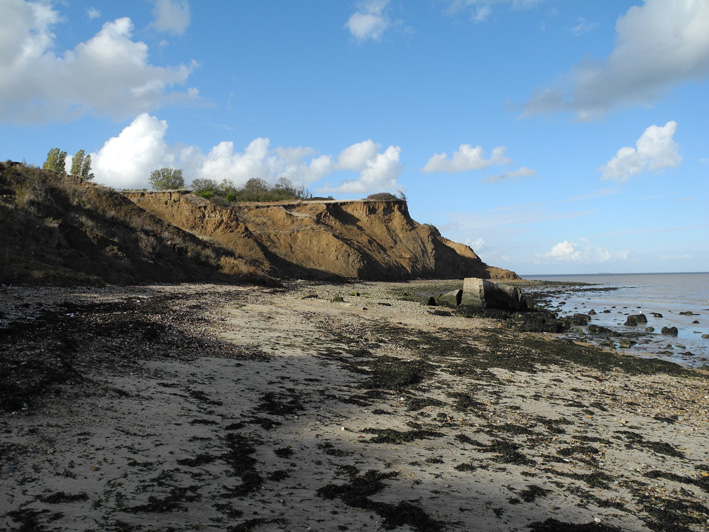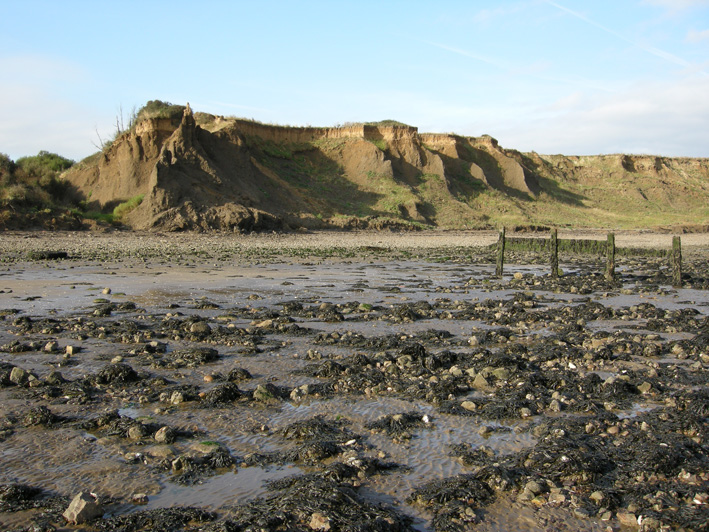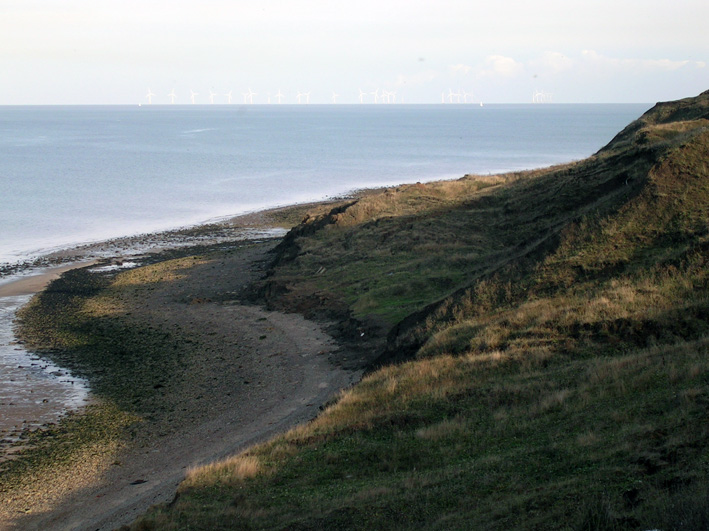THE CHURCH OF ST. JAMES AND SLIDING CLIFFS, WARDEN,
A painting in the primative style By Harold Batzer, about 1976 in the collection of the Sheppey Local History Society

.jpg)
GEOLOGICAL CHART OF THE CAENOZOIC ERA
AND SHEPPEY MAPS PAGES
Because this is a coastal site fossils are most commonly found amongst the pebbles on the beach. In situ fossils are rare and are almost impossible to find in the cliffs. Sometimes the silt is lifted from the clay exposures on the foreshore and in situ fossils as well as wave worn ones are exposed. The most common form of preservation is as iron pyrite casts which accumulate on the beach. These accumulations consist of small invertebrates such as shells, worm tubes, fragments of starfish, corals etc. Fossilised fish and sharks' teeth, and individual vertebra can be found in these accumulations. They are sorted into concentrations by gentle wave action. The collector should search for fresh concentrations. Phosphatic nodules containing crabs, lobsters and vertebrate remains, can be found scattered on the beach and on the foreshore. Larger nodules and cement stones usually concentrate towards the bottom of the beach and are rapidly worn by wave action and the effects of long-shore drift which constantly moves the pebbles and nodules. The persistent collector will be rewarded occasionally with freshly exposed fossils, beautifully preserved of exceptional detail and quality, but these finds are rare. Sheppey is particularly famous for the wide range of fruits and seeds to be found. Over 500 plant types and 350 named species are now recognised. These were probably carried out on the currents from the nearby river system as happens today in modern tropics, sinking when they became waterlogged. Rapid burial enabled the process of fossilisation

The Early Eocene (Ypresian) clays of Sheppey are a monotonous grey with horizontal bands of septarian cement stones and phosphatic nodules dispersed at irregular intervals vertically through the section. The lithography of the section is almost impossible to make out without studying the micro-fauna as well as the subtle changes within the clay. The detailed stratigraphy has been investigated by Chris King who established a lithostratigraphical and biostratigraphical succession and correlated this with other sections in the Eastern London Basin. His classic paper 'The stratigraphy of the London Clay Formation and Virginia Water formation in the coastal section of the Isle of Sheppey', published by the Tertiary research group (No.5) 1984 is essential reading for anyone looking for more than a superficial understanding of the Sheppey section.( For other important papers undertaken about the Sheppey section contact the Tertiary Research Group.)

Edward Jacob, Born about 1710, lived in Faversham until 1735 before moving to Nutts Farm, Leysdown in 1752. He was a member of the Antiquarian society and a keen naturalist. He made detailed studies of Sheppey's flora and fossils. He was one of the first to recognise the importance of the island's fossil flora and fauna. He wrote books on these subjects, namely "Fossilia Sheppeiana or Fossil Bodies, native and Extraneous of the Island of Sheppey" and "Plantae Favershamienses" which contains an appendix giving a detailed description of Sheppey fossils. All of the fossils described by Mr. Jacob can still be found today.
William Shrubsole was born in Faversham in 1837 and moved to Sheerness in 1851 to join his brother in business. During the late 19th. Century, Mr Shrubsole became acquainted with an old Irishman known as 'Paddy' Hayes, a local fossil collector from Blue Town, But it was not until after the death of Mr Hayes that he embarked on a serious study of Geology. Shrubsole carried out valuable research into the London clay fossil flora and fauna on the island. He presented several valuable specimens to the British Museum. His most important discoveries were the wing bones of an albatross type bird Argillornis longipennis, new genus and species of estuarine gastropods, and the remains of a turtle Chelone gigas and several fossil fruits.



